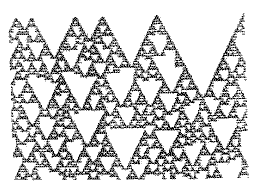 |
Science Frontiers ONLINE No. 101: Sep-Oct 1995 |
|
|
The algorithmic beauty of seashells
Most will admit that many seashells are pretty, but how did all those colors and geometrical markings arise? Perhaps a more profound question is: Why do sea-shells need to be pretty in the first place? After all, most (but not all) of the shell owners do not have eyes with which to appreciate their handiwork! However, mathematicians and computer modellers do have eyes. They have also had a lot of fun and some success in devising algorithms (mathematical methods) for the generation of seashell markings. In fact, our title above is also the title of a new book by H. Meinhardt, which suggests how a suite of simple biochemical processes can create those shells coveted by collectors.
Meinhardt has devised equations that describe chemical factors that turn pigment-generating cells on and off. In its simplest form, a mathematically modelled seashell is a two-dimensional sheet that grows along only one edge. Cells on this edge may or may not secrete pigment depending upon chemical "influences." B. Hayes describes how this sort of model operates:
 The triangular pattern on Cymbiola innexa suggests the presence of a "global control element" that turns the pigment-secreting cells on and off in the correct order -- something like a computer-controlled loom! |
"Given this generating mechanism, some shell patterns are easy to understand. A series of vertical stripes -- that is, stripes running perpendicular to the growing edge -- implies a static distribution of pigment secreting cells in the mantle margin. Where a cell or group of cells is permanently turned on, there is a dark stripe of pigment, and where the cells are dormant, there is an unpigmented space. The complementary pattern -- horizontal stripes, parallel to the growing edge -- results from a temporal rather than a spatial oscillation. All the secretory cells turn off and on in synchrony, so that light and dark bands are left behind on the surface of the shell as the growing edge moves on."
All well and good, but some seashells have intricate patterns that require modellers to imagine traveling waves of excitation, oscillating chemical systems, signals that travel faster than chemical diffusion, and longrange synchrony employing a "global control element." These patterngenerating schemes are clever and rather successful on the theoretical level. Indeed, the seashell modellers are rather smug about their accomplishments. (Hayes, Brian; "SpaceTime on a Seashell," American Scientist, 83:214, 1995.)
Comment. The seashell modellers, of course, do not have to explain how or why "global control elements" evolved. The biological rendering of "long-range synchrony" is left unexplained. Although humans will pay large sums for intricately patterned seashells, the anomalist must ask why these patterns exist at all? Why are they beautiful? Of what use are the patterns to the sea-shell inhabitants who cannot appreciate them?